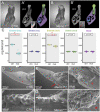MEMO1 Is Required for Ameloblast Maturation and Functional Enamel Formation
- PMID: 37475472
- PMCID: PMC11066519
- DOI: 10.1177/00220345231185758
MEMO1 Is Required for Ameloblast Maturation and Functional Enamel Formation
Abstract
Coordinated mineralization of soft tissue is central to organismal form and function, while dysregulated mineralization underlies several human pathologies. Oral epithelial-derived ameloblasts are polarized, secretory cells responsible for generating enamel, the most mineralized substance in the human body. Defects in ameloblast development result in enamel anomalies, including amelogenesis imperfecta. Identifying proteins critical in ameloblast development can provide insight into specific pathologies associated with enamel-related disorders or, more broadly, mechanisms of mineralization. Previous studies identified a role for MEMO1 in bone mineralization; however, whether MEMO1 functions in the generation of additional mineralized structures remains unknown. Here, we identify a critical role for MEMO1 in enamel mineralization. First, we show that Memo1 is expressed in ameloblasts and, second, that its conditional deletion from ameloblasts results in enamel defects, characterized by a decline in mineral density and tooth integrity. Histology revealed that the mineralization defects in Memo1 mutant ameloblasts correlated with a disruption in ameloblast morphology. Finally, molecular profiling of ameloblasts and their progenitors in Memo1 oral epithelial mutants revealed a disruption to cytoskeletal-associated genes and a reduction in late-stage ameloblast markers, relative to controls. Collectively, our findings integrate MEMO1 into an emerging network of molecules important for ameloblast development and provide a system to further interrogate the relationship of cytoskeletal and amelogenesis-related defects.
Keywords: amelogenesis; amelogenesis imperfecta; cell polarity; cytoskeleton; mineralization; tooth.
Conflict of interest statement
Declaration of Conflicting InterestsThe authors declared no potential conflicts of interest with respect to the research, authorship, and/or publication of this article.
Figures





Similar articles
-
Stim1 Regulates Enamel Mineralization and Ameloblast Modulation.J Dent Res. 2017 Nov;96(12):1422-1429. doi: 10.1177/0022034517719872. Epub 2017 Jul 21. J Dent Res. 2017. PMID: 28732182
-
Enamel and dental anomalies in latent-transforming growth factor beta-binding protein 3 mutant mice.Eur J Oral Sci. 2017 Feb;125(1):8-17. doi: 10.1111/eos.12328. Eur J Oral Sci. 2017. PMID: 28084688 Free PMC article.
-
Critical role for αvβ6 integrin in enamel biomineralization.J Cell Sci. 2013 Feb 1;126(Pt 3):732-44. doi: 10.1242/jcs.112599. Epub 2012 Dec 21. J Cell Sci. 2013. PMID: 23264742
-
Cellular and chemical events during enamel maturation.Crit Rev Oral Biol Med. 1998;9(2):128-61. doi: 10.1177/10454411980090020101. Crit Rev Oral Biol Med. 1998. PMID: 9603233 Review.
-
Structure and function of secretory ameloblasts in enamel formation.Ciba Found Symp. 1997;205:32-46; discussion 46-50. doi: 10.1002/9780470515303.ch4. Ciba Found Symp. 1997. PMID: 9189616 Review.
Cited by
-
The Morphogenesis, Pathogenesis, and Molecular Regulation of Human Tooth Development-A Histological Review.Int J Mol Sci. 2025 Jun 27;26(13):6209. doi: 10.3390/ijms26136209. Int J Mol Sci. 2025. PMID: 40649989 Free PMC article. Review.
References
-
- Aldred MJ, Savarirayan R, Crawford PJ. 2003. Amelogenesis imperfecta: a classification and catalogue for the 21st century. Oral Dis. 9(1):19–23. - PubMed
-
- Balic A, Thesleff I. 2015. Tissue interactions regulating tooth development and renewal. Curr Top Dev Biol. 115:157–186. - PubMed
-
- Caton J, Bringas P, Jr, Zeichner-David M. 2005. IGFs increase enamel formation by inducing expression of enamel mineralizing specific genes. Arch Oral Biol. 50(2):123–129. - PubMed
MeSH terms
Grants and funding
LinkOut - more resources
Full Text Sources
Molecular Biology Databases

